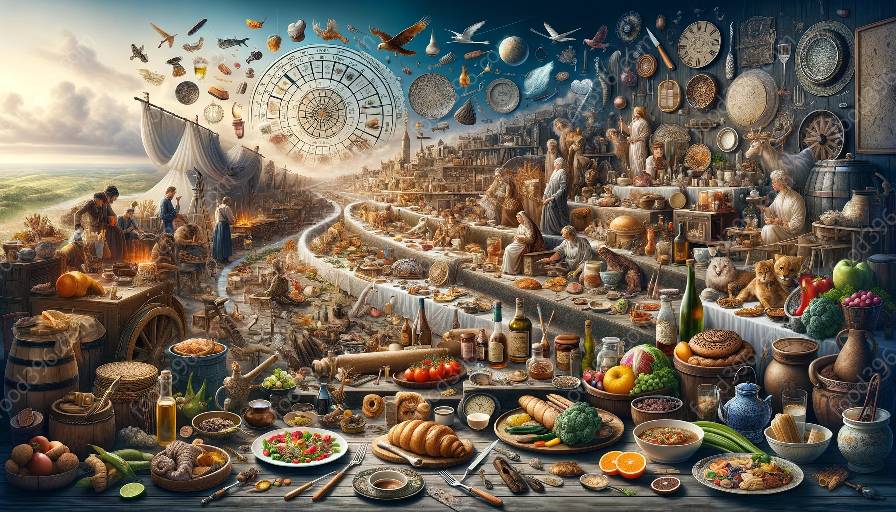Modern Spanish cuisine has undergone significant changes and evolution from the era of Franco's dictatorship to the present day. Understanding the impact and development of modern Spanish cuisine requires examining the historical, cultural, and social influences that have shaped it over time. This topic cluster aims to provide a comprehensive exploration of the transformation of Spanish cuisine, its key milestones, and the factors that have contributed to its current state.
Spanish Cuisine History
The history of Spanish cuisine is a rich tapestry that is interwoven with various influences, including the Roman, Moorish, and Christian traditions. The abundance of fresh produce, diverse climates, and culinary techniques have all played a role in shaping Spain's gastronomic identity. Additionally, the Age of Discovery further enriched Spanish cuisine with the introduction of new ingredients from the Americas and other parts of the world. Over time, regional culinary variations emerged, contributing to the vast and diverse nature of modern Spanish cuisine.
Cuisine History
Understanding the broader context of cuisine history is essential in comprehending the evolution of modern Spanish cuisine. The exchange of culinary traditions, the impact of historical events on food production and consumption, and the development of global trade routes have all influenced the way we perceive and experience food. Furthermore, the shifting socio-political landscapes have played a pivotal role in shaping culinary practices, including those of Spain. Through exploring cuisine history, we gain valuable insights into the interconnectedness of food, culture, and societal dynamics.
The Evolution of Modern Spanish Cuisine
1. Franco's Dictatorship and its Effects
During the Francoist regime, Spanish cuisine experienced a period of stagnation and limited culinary innovation. The authoritarian rule and economic constraints imposed by the regime led to a lack of diversity in food production and consumption. The emphasis was on maintaining traditional culinary practices, which resulted in a certain degree of culinary homogeneity across the country.
2. Transition to Democracy
The transition to democracy marked a significant turning point in the evolution of modern Spanish cuisine. With the end of the dictatorship, there was a newfound sense of freedom and creativity, which extended to the culinary realm. This period saw a resurgence of regional culinary identities and a renewed interest in traditional ingredients and cooking techniques.
3. Global Influences and Culinary Innovation
As Spain opened up to the world in the post-Franco era, global influences began to permeate the culinary landscape. The influx of international culinary trends, as well as the fusion of traditional Spanish flavors with innovative approaches, contributed to the emergence of modern Spanish cuisine as we know it today. Chefs and food enthusiasts alike began to experiment with new flavors, techniques, and presentations, leading to a culinary renaissance across the country.
Key Milestones in Modern Spanish Cuisine
1. Introduction of Nouvelle Cuisine
The introduction of Nouvelle Cuisine in the 1970s had a profound impact on modern Spanish cuisine. Characterized by its emphasis on fresh, high-quality ingredients and artistic presentation, Nouvelle Cuisine inspired a generation of Spanish chefs to elevate their culinary creations and embrace a more refined approach to cooking.
2. Emergence of Molecular Gastronomy
The pioneering work of chefs such as Ferran Adrià and his famed restaurant, elBulli, brought molecular gastronomy to the forefront of modern Spanish cuisine. This avant-garde culinary movement redefined traditional cooking methods and pushed the boundaries of flavor, texture, and presentation, placing Spain at the forefront of culinary innovation on the global stage.
3. Recognition of Spanish Gastronomy
The acknowledgment of Spanish gastronomy as an integral part of the country's cultural heritage has contributed to its promotion and celebration on a national and international level. With the inclusion of Spanish cuisine in UNESCO's Representative List of the Intangible Cultural Heritage of Humanity, there has been a heightened appreciation and preservation of traditional culinary practices and regional specialties.
Culinary Diversity and Regional Specialties
The varied landscapes and climates of Spain have given rise to a rich tapestry of regional culinary specialties, each reflecting the unique terroir and cultural traditions of its respective area. From the bold flavors of Basque cuisine to the seafood-centric dishes of Andalusia, the diversity of Spanish regional cuisines adds depth and vibrancy to the overall culinary landscape of the country.
Influence on Contemporary Gastronomy
The impact of modern Spanish cuisine extends beyond the borders of Spain, with its influence resonating across the global culinary scene. The innovative techniques, creative presentations, and emphasis on high-quality ingredients have inspired chefs and food enthusiasts worldwide. Spanish culinary concepts, such as tapas and paella, have become ubiquitous in international dining establishments, further solidifying the global appeal of modern Spanish cuisine.
Conclusion
The journey of modern Spanish cuisine, from the constraints of Franco's dictatorship to the present-day celebration of culinary diversity and innovation, encapsulates a narrative of resilience, creativity, and evolution. The interplay of historical, cultural, and social influences has shaped the gastronomic identity of Spain, contributing to a dynamic and thriving culinary landscape that continues to capture the hearts and palates of people around the world.

